| Description: |
Morin, a α-glucosidase inhibitor with an IC50 value of (4.48 ± 0.04) uM, it also exhibits inhibition in the generation of advanced glycation end products which was related to the long term complications of diabetes. Morin has anti-inflammatory and anti-oxidative effects by activating Nrf2 signal pathways and inhibiting NF-κB activation. it can be used to prevent bladder cancer, it prevents MMP-9 expression via the inhibition of transcription factors AP-1, Sp-1, and NF-κB. |
| In vitro: |
| Eur J Pharmacol. 2017 Apr 15;801:9-18. | | Morin activates the Nrf2-ARE pathway and reduces oxidative stress-induced DNA damage in pancreatic beta cells.[Pubmed: 28216051 ] | Oxidative stress is an important factor contributing to the pathogenesis of diabetes and its complications.
In our earlier study, we demonstrated the antidiabetic efficacy of Morin by regulating key enzymes of carbohydrate metabolism in diabetic rats. The present study was designed to assess the antigenotoxic potential of Morin in pancreatic β-cells, using the COMET assay.
METHODS AND RESULTS:
To explore its potential mechanisms of action, three genotoxic agents, H2O2 which induces DNA damage by the generation of reactive oxygen species, streptozotocin (STZ) by RNS and Methyl methanesulfonate (MMS) by DNA alkylation was used. We found that STZ and H2O2- induced genotoxicity was dose dependently reduced by Morin as assessed by DNA tail length, tail moment, DNA content and olive moment. Since the protective property was found to be specific against oxidative DNA damage, we explored the molecular mechanism underlying Morin-induced Nuclear factor erythroid 2-related factor 2 (Nrf2) activation in pancreatic β-cells as assessed by ARE-driven downstream target genes with Luciferase reporter assay. In addition, Morin inhibited intracellular free radical generation as assessed by using DCFDA and increased the intra cellular antioxidants viz, superoxide dismutase and catalase in INS-1E cells. In addition, Morin attenuated glucose-stimulated insulin secretion following exposure to oxidative stress by STZ (P<0.05).
CONCLUSIONS:
Collectively, our data provide evidence that Morin protects pancreatic β-cells against oxidative stress-induced DNA damage by activating the Nrf2 signaling pathway. | | Drug Dev Res. 2017 Mar;78(2):81-90. | | Morin Inhibits Proliferation, Migration, and Invasion of Bladder Cancer EJ Cells via Modulation of Signaling Pathways, Cell Cycle Regulators, and Transcription Factor-Mediated MMP-9 Expression.[Pubmed: 28176369] | Preclinical Research Previous studies have shown that Morin exerts diverse pharmacological activities. In this study, we investigated the inhibitory activity of Morin on bladder cancer EJ cells.
METHODS AND RESULTS:
Morin significantly inhibited EJ cell proliferation, which was related to the G1-phase cell cycle arrest together with the reduced expression of cyclin D1, cyclin E, CDK2, and CDK4 via increased expression of p21WAF1. Morin also increased ERK1/2 phosphorylation and decreased JNK and AKT phosphorylation without altering the p38MAPK phosphorylation levels. Morin treatment suppressed the migration and invasion of EJ cells in wound-healing and transwell cell invasion assays. Zymographic and electrophoretic mobility shift assays showed that Morin suppressed the expression of matrix metalloproteinase-9 (MMP-9) via repression of the binding activity of AP-1, Sp-1, and NF-κB.
CONCLUSIONS:
Collectively, these results demonstrate that Morin reduced cyclin D1, cyclin E, CDK2 and CDK4 expression via the induction of p21WAF1 expression, increased ERK1/2 phosphorylation and decreased JNK, and AKT phosphorylation, and prevented MMP-9 expression via the inhibition of transcription factors AP-1, Sp-1, and NF-κB, thereby resulting in the inhibition of growth, migration, and invasion of bladder cancer EJ cells.
These results provide a novel insight into the use of Morin in the prevention of bladder cancer. |
|
| In vivo: |
| Int Immunopharmacol. 2017 Apr;45:148-155. | | Protective effects of morin on lipopolysaccharide/d-galactosamine-induced acute liver injury by inhibiting TLR4/NF-κB and activating Nrf2/HO-1 signaling pathways.[Pubmed: 28213269 ] | Morin, a bioactive flavonoid extracted from the bark of Moraceae plants and many medicinal herbs, has anti-inflammatory and antioxidative effects. In this research, we explored the protective effects of Morin against lipopolysaccharide (LPS) and d-galactosamine (D-GalN) induced acute liver injury in mice.
METHODS AND RESULTS:
Mice were given an intraperitoneal injection of Morin before LPS and D-GalN treatment and the HepG2 cells were only given Morin to investigate its effects. The results showed that Morin markedly inhibited the production of serum alanine transaminase (ALT), aspartate aminotransferase (AST), interleukin-6 (IL-6), tumor necrosis factor (TNF-α) and hepatic TNF-α, IL-6, and myeloperoxidase (MPO) induced by LPS/D-GalN. In order to evaluate Morin effect in the future, we investigated the expression of nuclear factor E2 related factor 2 (Nrf2), nuclear factor-kappaB (NF-κB), toll like receptor 4 (TLR4) on liver injury.
CONCLUSIONS:
Taken together, these results suggested that Morin could exert the anti-inflammatory and anti-oxidative effects against LPS/D-GalN-induced acute liver injury by activating Nrf2 signal pathways and inhibiting NF-κB activation. |
|






 Cell. 2018 Jan 11;172(1-2):249-261.e12. doi: 10.1016/j.cell.2017.12.019.IF=36.216(2019)
Cell. 2018 Jan 11;172(1-2):249-261.e12. doi: 10.1016/j.cell.2017.12.019.IF=36.216(2019) Cell Metab. 2020 Mar 3;31(3):534-548.e5. doi: 10.1016/j.cmet.2020.01.002.IF=22.415(2019)
Cell Metab. 2020 Mar 3;31(3):534-548.e5. doi: 10.1016/j.cmet.2020.01.002.IF=22.415(2019) Mol Cell. 2017 Nov 16;68(4):673-685.e6. doi: 10.1016/j.molcel.2017.10.022.IF=14.548(2019)
Mol Cell. 2017 Nov 16;68(4):673-685.e6. doi: 10.1016/j.molcel.2017.10.022.IF=14.548(2019)